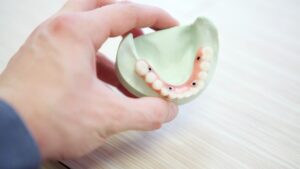02 Jan How Do All-on-4 Dental Implants Differ from Other Types of Implants?
Usually, dental implants have to be surgically placed one at a time. But with All-4-One dental implants, you can replace all of your lower or upper teeth with just a few anchor implants. It’s quickly becoming a welcomed alternative to dentures that can slip and slide. But it’s important to understand how these implants differ from others.
Only One Procedure Necessary
With traditional dental implants, you have two visits. The first step is inserting the implant into the jawbone and letting everything heal. Then, after several months, the abutment and the crown are placed. This means waiting a while and having two procedures for your implant.
All-on-4 dental implants work a bit differently. Due to the way the implant is placed, you only need a single procedure. This means you get tooth restoration in a single day. It’s quicker and easier.
It’s important to note that you get a temporary set of teeth during an All-on-4 procedure. You’ll go back a few months later to get your permanent set. However, you still leave with teeth on day one.
All-on-4 Dental Implants Offer Full Mouth Restorations
If you’re dealing with brittle teeth or decay for any reason, you might think dentures or individual implants are your only options. While you can have each tooth replaced with dental implants, that will be a lengthy procedure and likely take numerous trips to give your mouth time to heal.
With All-on-4 implants, you only need four implants for the top and four implants for the bottom, hence, the “4” in the name. Two implants are placed near the back on either side of your mouth. The other pair is placed closer to where your canines would be. Then, your dentures would anchor into place using these four implants.
Bone Density Isn’t a Problem
One of the most notable differences between All-on-4 dental implants and regular implants is bone density requirements. While implants are the best option for restoring a missing tooth, you have to have enough bone density for the implant to connect to. If you’ve been dealing with a gap or missing a tooth for a while, the bone may be too weak to support the implant.
With All-on-4 implants, the implants are placed where the bone is naturally strongest. The bone rarely weakens in these areas, making you a more viable candidate even if your teeth have been missing for a while.
Want to learn more about how COOMSA’s Teeth In A Day procedure works? Schedule an appointment today for a consultation.
